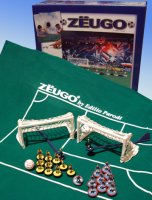
| Peter Upton's |
Subbuteo Tribute Website. |
|
Subbuteo Football Clones in the 21st Century. |
|
Zëugo - by Edilio Parodi (1997-date). |

Zëugo is an Italian Subbuteo table football clone that was first introduced in 1997. It was designed by Edilio Parodi, and is produced by the company that bears his name. Parodi was the Italian distributor of Subbuteo products from the 1970s until 1995. When Hasbro acquired Waddingtons they told Parodi that they would be doing their own distribution, and Parodi would no longer be able to supply the product. Not wanting to lose all that expertise in his Italian market, Parodi produced this game to fill the gap. Parodi has a great reputation among the Italian table soccer fraternity, and his name is featured prominently on the boxes. The game was originally going to be called "play by play", but the final name of Zëugo came from a Genoese dictionary, and simply means "game". Parodi were based in Genoa, and he liked the Subbuteo-like sound of the word.
The Original Range 1997-2001.
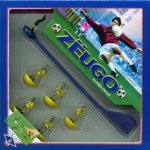

Initially, a standard box set was released with pitch, goals, two sizes of ball, and two teams in red and blue. So far, so Subbuteo! Later sets had different teams, with a final version using Aston Villa and Wolves who were also the final two sides in the original team range. The pitch was a quality cloth one, unlike the 1990s Subbuteo nylon efforts, and the goals were a more robust version of the classic C130 World Cup goal. The player figures were based on the Subbuteo heavyweight figure of the 1970s but are clearly a second generation casting, being fatter and slightly less detailed than the Subbuteo equivalent. They were hand-painted in China, usually with a thick paint that looks bold and bright in play. The goalkeeper was on a blue rod, which was a couple of centimetres longer than the Subbuteo version.
When I first produced this site, I pointed out that the game was obviously Subbuteo table soccer under a different name, and wondered whether all the Subbuteo patents have expired. Clearly they had, and others have followed the route trail blazed by Parodi.
Unsurprisingly, Zëugo launched with a range of teams to keep players and collectors happy. This was obviously dominated by Italian club sides, but also had a few other top European sides, and some famous national teams. The original range consisted of 52 teams, and this was later expanded to 56. This original range can be viewed on the Zëugo Team Appendix page. The players were also available to buy unpainted, and the Woodentop shop in the UK did sell its own range of sides for a few years, covering most of the English and Scottish leagues, and other sides as requested.

The game also had an accessory range, but with the original launch this was essentially just spares for items in the box set; a pitch, goals, balls and goalkeepers. Subbuteo accessories were not thin on the ground at the time, and Parodi probably felt that teams would be the main attraction. However, there is one glorious exception to this rule. Zëugo has one accessory that Subbuteo doesn't have, although you may need a bigger house to enjoy it. This accessory is the running track. As the picture shows, this is a six lane track that fits around the Subbuteo pitch for the authentic European stadium look. Seeing as the Subbuteo pitch is already too big for some dining room tables, you may have to push two tables together to get the running track to fit. Add a full stadium around the outside of your running track, and you have a Stadium fit for the Champions League.... Except that the only way to reach the pitch to actually play the game would be to float down from above in a Tom Cruise/Mission Impossible type way.
In 2002 Edilio Parodi snc were granted a licence to produce genuine Subbuteo products by Hasbro. Parodi's Chinese workforce turned to painting Subbuteo teams, and the Zëugo range halted. When that licence expired in 2005, Zëugo was resurrected with a new range.
2004-05 Range.
With the end of Parodi's Subbuteo licence, the Zëugo range pretty much carried on where it left off. Rather than reproduce the original fifty six teams, the new version took forty four popular teams from the existing Parodi Subbuteo range, and painted them onto the Zëugo figure. The teams were housed in the existing square box, as shown at the top of this page. The set too remained in the existing square box.
The one key difference was that the modern style flat bases designed for Parodi's Subbuteo range became the standard outer bases for the Zëugo range. I believe that the old style bases were still available (possibly on request), but all the teams/sets I've seen have the new bases. I think these 44 teams are the only later ones that came in the square box, and the Subbuteo style outer base.
The accessory range on the re-release remained unchanged - the pitch, balls, goals, goalkeepers and the athletics track.
Zëugo Range 2006.

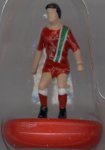
This is really where the modern Zëugo range begins. Most importantly, the base style changed again, and the clear distinction between heavyweight bases and modern sliding in Zëugo production was introduced. The history of Parodi bases is worth a little extra detail here. When Parodi obtained their licence sell Subbuteo products in 2002, Hasbro sent them their remaining stock from around Europe, but Parodi found that all the big selling sides were missing - they had already been sold. Therefore, they needed to produce their own Subbuteo teams to fill this important gap. Now, Parodi's skill was in distribution, so they approached Enrico Techiatti of Astrobase, to do the designs for the range - the bases, the figures, the accessories etc. He has told me that the base should be regarded as a Astrobase design not a Parodi one. (However, it is in the Parodi Subbuteo range, so that is still what I call it).
When Zëugo first returned, they adopted this base, but Astrobase also had designs for it - producing the rival Soccer 3D range using both base and figure from the Subbuteo production. Soon after this, Zëugo switched production to Profibases. Profibase are Astrobase's main rival for the expensive "professional" bases in the Italian table soccer community. This new Zëugo base is flatter and heavier than the earlier Astrobase one, and I regard these teams as the first really mass market "professional use" sides. Certainly, they are the one "straight out of the box" team set that is used regularly at my local table soccer club - the Worthing Five-Star. Just a really good beginners set.
However, part of the appeal of Zëugo was always it's reflection of 1970s Subbuteo, and the company was very aware that they did not want to lose that connection. The "retro" heavyweight playing community was also building momentum in Italy. So Parodi made their teams available in both the Profi-base, and a heavyweight style base. You can choose which type you wish to play with.
I should note that there is no hard feelings between these two Italian giants of the table soccer world. Astrobase still sell the full range of Zëugo. (They call the modern Zëugo base "the 3D power base").
There was more changes to the teams. Firstly, they were re-housed in an attractive blue box, which was more compact than the original design, but allowed room for a spare outfield player. Although the above illustration suggests a similar sized box to the Hasbro/Soccer 3D window boxes, these are actually quite a bit larger, and allow the players to be comfortably displayed and protected (as you can see with the Juventus player shown). The spare outfield player was a great idea. Zëugo players are quite a hard plastic, and although generally more robust than the original Subbuteo players, breaks can occur. Having a substitute prevents having to discard a team if your opponent treads on one of your players (a rare occurrence at the five-star club, but we have done this).
The Boxed Edition 2006.
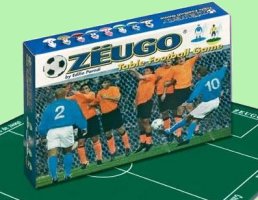
In October 2006 I wrote that I was surprised to see the new Zëugo box set featured in the catalogue (and website) of my local toy shop - Gamleys. In addition, the Freemans Christmas gifts catalogue of that year featured not only the set, but a range of Premiership kits to go with it. These teams were in the numbered Zëugo range, mostly between 50 and 75. This was the first time I had seen Zëugo on the High Street in the UK. The set was then a reasonable £19.99. I bought one of course, and saw a few at boot sales over the next few years, so pleasingly they did seem to sell.
This was a new edition of the game produced in a large flat box. Like the team boxes, this set was essentially copying the Parodi Subbuteo design. Unlike the old square set, this new version had no interior inserts, and the two teams were simply supplied in the standard team boxes (the teams were generic red/white and blue/white kits). The goals were the Zëugo reproduction of the Subbuteo World Cup goal (an all in one white casting). It was a lovely useable set, at a time when Subbuteo itself was in its "photo-real" phase.
I have seen later versions of this set which were improved with the addition of a clear plastic insert.
Accessories 2006 onwards....
The Zëugo accessory range also grew over this period. Not excessively, but with some really cute additions. Some of my pictures are from the later "green box" era (see below), but the range has remained pretty consistent over time, so I assume all the major accessories were produced in both types of packaging.
Balls.
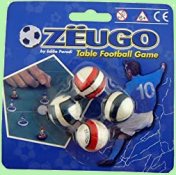
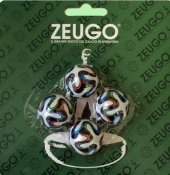
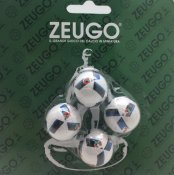
These have become the bread and butter of many a Subbuteo clone range. The standard Zëugo coloured balls of the period are illustrated, along with a couple of other versions. The Parodi website currently features three or four sets of balls with different references.
Goals.
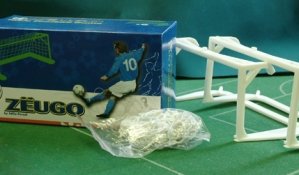
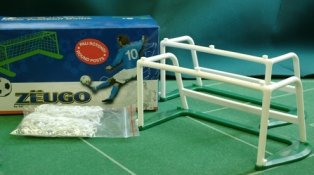
The original Zëugo one-piece "world cup style" goal was joined by a new style of goal on a green base. These were borrowed from the Parodi "black box" Subbuteo range, and were advertised as having "round posts". They are a much nicer looking goal all round. Note that they do have a back bar, which may hinder (or help) goalkeeping.
Pitches.
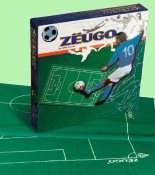
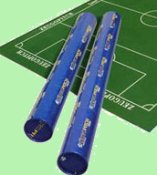
Again, this is a very Subbuteo related offering. The standard cloth pitch was available separately, but Zëugo also had their own rolled up Astropitch alternative..
The Fence.
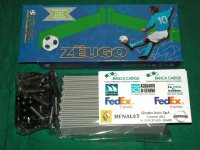
The Zëugo fence which, like other products, originally came from the Parodi Subbuteo range. It had black posts, and white advertising boards, with a nice range of stickers to decorate it with.
Spectators - Painted and Unpainted.
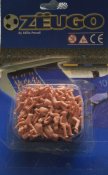
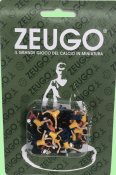
Old Subbuteo spectators had started to get expensive on ebay, as stadium builders struggled to fill their stands. These identical Zëugo ones were produced very early in the range, a quick and easy money spinner I assume. Painted spectators came a little later - boxed in packs of fifty, as opposed to the measly ten painted spectators that Subbuteo had once offered. The Chinese workforce must be cheaper....
Stadia.
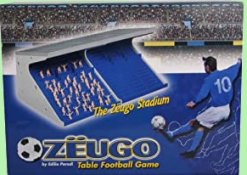
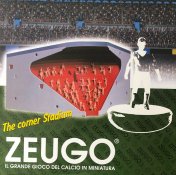
I always called the stadium the "cherry on the cake" of Subbuteo production. The point where all the little stadium details were put in their place. So it was a lovely surprise to see Zëugo embrace this level of design (mind you, the aforementioned athletics track showed that the company was thinking big). The Zëugo stands are pleasingly similar to the 1980s-90s Subbuteo versions in red and blue. However, the stands are cut down to just one level. This matches the terracing of old, but with the bonus of roofing - to both the stands, and uniquely, the corner terracing. A very nice addition.
Benches, managers, referees, flags etc.
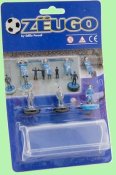
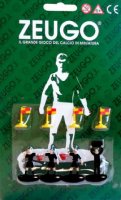
Some more lovely little sets to add to the look of that Stadium. The benches are unique to Zëugo, and have a great little selection of reserves and management. The referees have been borrowed from the final Hasbro Subbuteo range, although amended to fit a heavyweight style Zëugo base. The fourth official holding up a board, is in various modern table soccer sets. The flags look pretty dinky.
The Team Range.
With so many clubs wanting unique colours, and most kits only lasting for a year, any modern table soccer range that attempts to keep up sees their team range swiftly increasing year on year. Whilst this is great for the casual buyer, it is really self-defeating as a collectables strategy. It simply isn't possible for most collectors to find room for 300 teams... from several ranges... it is just overwhelming.
Although the Zëugo range does grow year on year, they have, on the whole, avoided the excesses of the smaller leagues and nations. They have the occasional foray into the English lower leagues, or the European leagues outside of Italy and the UK, but mostly they stick to their core markets, and the national sides who have qualified for the World Cup or European championships. The range has faced the usual problem of using new numbers, or updating kits on the same numbers (and annoyingly, I think they have done both)
Here I've left in the original website dating and comments, although tweaked slightly as my understanding of the team range has grown.
April 2009: At this point, online Italian retailer Astrobase had the range reaching team number 122, but with earlier teams dropping from the range as they sold out. I had spotted that newer versions of the same clubs do not always get the same number in the range.
UK online retailer Subbuteoworld had gone over completely to Zëugo at this point (dropping the Soccer 3D range). They had their own exclusive range, that was bigger than the official version, and had numbers reaching into the 200s with extra Premiership away kits, and national sides. However, their numbering on the website never tied up to the official range, and I have seen plenty of Zëugo teams online with no numbers on the boxes, which may have been from this range. It adds to the fun, and confusion with Zëugo, and makes me glad I'm not cataloguing this stuff....
May 2010: A new team chart was produced by Parodi matching the Astrobase numbering (rather than the Subbuteoworld stuff). This reached reference 161 teams, but only 114 teams were still available (as numbers are dropped as kits get replaced). In addition, 162-180 covered all the qualifiers for the 2010 World Cup who were not already being produced.
The Green Box Era 2012 onwards.

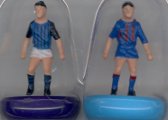
I split the green box era into a new section on my old clone pages, and have done the same here. However, the re-box actually changes very little. The teams, box interiors and accessory range stay the same. All that happens is that the team range continues to expand.....
2012: The Zëugo teams are now housed in a minimalist green and white box, perhaps attempting to highlight its popularity with 1970s Subbuteo player/collectors who appreciate the shape of player and the hand-painted look. Pleasingly, the large box size remains, as does the spare player. Teams are available with either the modern Profi-base, or a more traditional 1970s style base. Teams with this older style of base have a sticker on the box stating "HW base", to make it easier to tell them apart.
The Zëugo range was still expanding rapidly, as Italian table soccer team collections seem destined to do. The teams illustrated above are ref 250 Rochdale and 258 Inverness. The Rochdale were from Zëugo's single attempt to cover what is now League One in 2011. They picked a good year for team collectors, as two newly promoted league teams - Crawley, and Stevenage - had reached this level. So this was the first time they had appeared in one of the bigger table soccer ranges.
Elsewhere, Zëugo seemed content to try and keep on top of Serie A (so Novara were produced), the Premier League, and the Scottish Premier (hence the Inverness here, and also Ross County). Plus their usual national team updates.
Zeugo Official 2012 England Euro Finals team - Vauxhall Promotional Kit.
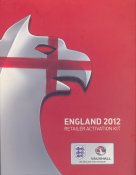
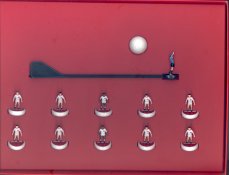
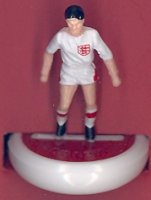
Vehicle manufacturer Vauxhall were an official sponsor of the England football team, and had this item produced as part of a promotional sales pack for the 2012 Euros.
Whilst Zeugo always had an England team in their standard range, the advantage
to this version is that it was produced under the official Vauxhall licence, so
it has the proper "three lions" badge, and is a lovely recreation of the 2012
kit. As it was essentially a little gift for the retailer, I imagine it was
produced in very small numbers. Does anyone know of any other Zeugo promotional
activity?
Inside - New Table Football Generation (by Zeugo) Edilio Parodi is so well associated with Subbuteo/table soccer
in Italy, that his name sells the game. However, outside of Italy, this is not
the case, and the word Zëugo is meaningless and tricky to pronounce. In the
barren Subbuteo years between the Parodi licence and the Netcam one, two table
soccer playing Belgian brothers, by the name of Vanton, wanted to expand the Zëugo game into Belgium and France. They formed a company, SPRL Play the Game
International, and bought a licence for Zëugo for these two markets. They
renamed the game as Inside (or Inside Football). The game launched with a box
set (shown above), plus a range of teams. The teams included the
predicable top nations (top European ones, plus Brazil and Argentina), and the big
European club sides (such as Liverpool and AC Milan). However, they also
launched a more comprehensive range of Belgian and French club sides. To add to the confusion,
these were given reference numbers in the standard Zëugo range (so the Belgian
sides are mostly in the 120s). Perhaps more interesting was an attempt to produce an Inside
rugby box set. I've been told that about 50 (or 100?) of these were made, featuring
France and New Zealand. Hopefully the pictures give a feel of the game. There
was a redesigned scrummer, and a ball that is bigger than Subbuteo rugby, and
seems to work differently. The
heavy flat bases of Zëugo seem well suited to a rugby game. I wonder what it
played like? It was never released to the shops though. Sadly, even with a renamed product, the Vanton brothers had
trouble getting the game into toy shops, who couldn't see past the lack of "Subbuteo"
branding. Eventually, they did manage to sign an exclusive deal with the French
toy shop "Joue Club", but sales proved to be disappointing, and the game was
discontinued. A real shame. As a member of the international collecting community, I'd grown
so used to seeing Zëugo products that I was puzzled as to why this identikit
product was launched. So a big thank you to Thomas Ponté, who
explained all. August 2022: I found I had a couple of pictures of Inside
Football accessories, so I asked Thomas what was released. He seemed to
think that it was just the balls and the fence. He said that more were
planned, but the shops never asked for them. You can see the branding for
the French toy shop stockist on the bottom left of the boxes. The 2020 Zeugo Range.
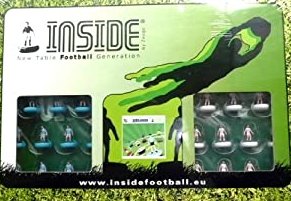
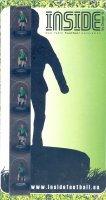
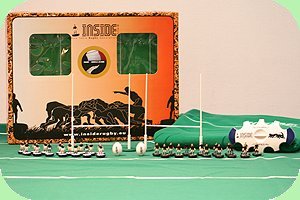
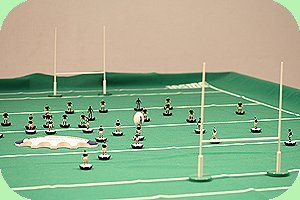
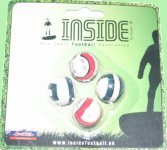
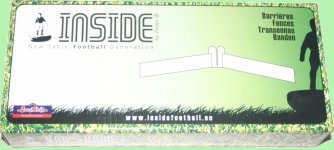
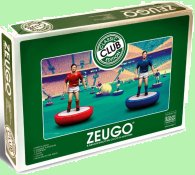
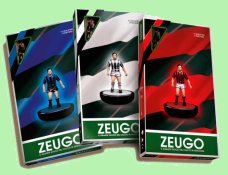
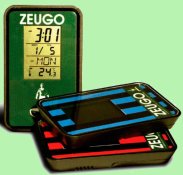
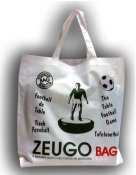
Here then is the up-to-date Zëugo club edition, and some quirky additions. The company does continue to innovate in its packaging of the game. There is a new playing figure logo that suggests a modern figure design, but this is not actually the case. Limited edition boxes for the bigger Italian clubs, and special editions for club anniversaries are new. Interestingly, the basic set up can now be bought in a bag or a backpack format (pitch, goals, balls and teams of course). There is also a new Zëugo timer, which along with the stopwatch has date and temperature functions (this would be very useful in the wintry "fridge" we call the Worthing Five-Star club venue....)
The official Zëugo team range is now over 350, and once again, Subbuteoworld is receiving exclusive versions of certain references - this time tweaked for the UK market (for example the halved Juventus, becomes a Fulham).
As mentioned at the start, you can view the original Zëugo team range at Zëugo teams 1-54. However, the new team range is certainly too big and complicated to be illustrated. I may put up a straight name listing if enough people ask for it.....
Of course, if you want to keep up with the latest Zëugo developments, then the Edilio Parodi website is the place to go.
If you want a full illustrated list of the Zëugo teams, you can visit fan site The Zeugo Catalogue. A really comprehensive website for this attractive game.
That's it for Zëugo, so return to the Clones Page or just pick another topic.